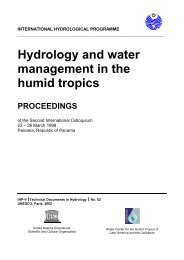FR AB - Science Reference
FR AB - Science Reference
FR AB - Science Reference
You also want an ePaper? Increase the reach of your titles
YUMPU automatically turns print PDFs into web optimized ePapers that Google loves.
RESEARCH GROUP<br />
REPORTS<br />
Strategies for the Synthesis<br />
of Labeled Peptides<br />
Lisa Bibbs, a Nicholas P. Ambulos, b<br />
Steven A. Kates, c Ashok Khatri, d<br />
Katalin F. Medzihradszky, e<br />
George Ösapay, f and<br />
Susan T. Weintraub g<br />
a The Scripps Research Institute, La Jolla, CA;<br />
b University of Maryland at Baltimore,<br />
Baltimore, MD; c PerSeptive Biosystems, Inc.,<br />
Farmingham, MA; d Massachusetts General<br />
Hospital, Boston, MA; e University of California,<br />
San Francisco, CA; f University of California,<br />
Irvine, CA; g University of Texas Health <strong>Science</strong><br />
Center at San Antonio, San Antonio, TX<br />
Labeled peptides synthesized by core facilities are frequently<br />
used by researchers for following trafficking of a peptide, for<br />
binding studies, to determine substrate specificity, and for<br />
receptor cross-linking studies.The membership of the Association<br />
of Biomolecular Resource Facilities was asked to participate<br />
in a study focusing on synthesis of a biotin-labeled<br />
peptide, and it was suggested that a new strategy, using Rink<br />
amide 4-methylbenzhydrylamine resin coupled with Fmoc-<br />
Lys(Dde)-OH, be used.This strategy can be used for addition<br />
of a variety of labels other than biotin and should prove useful<br />
to core facilities. Comparison of the new strategy to<br />
other strategies was performed. Biotin labeling has long been<br />
ADDRESS CORRESPONDENCE AND REPRINT REQUESTS TO: Lisa Bibbs,<br />
The Scripps Research Institute, Core Facility, SP-3, La Jolla, CA<br />
92037 (email: bibbs@scripps.edu).<br />
assumed to be routine and specific. Despite the assumed<br />
routine nature of synthesizing biotinylated peptides, 9 of the<br />
34 samples submitted did not contain any of the correct<br />
product. Although synthesis using Fmoc-Lys(Dde)-OH plus<br />
biotin generally gave the highest yields, other approaches<br />
also yielded a high percentage of the correct product.Therefore,<br />
the various strategies are generally comparable. The<br />
major advantage of this new approach is that other labels<br />
such as fluorescein, dansyl groups, methyl coumarin, and<br />
potentially fluorophores and quenchers used for fluorescence<br />
resonance energy transfer (<strong>FR</strong>ET) can be directly<br />
incorporated into peptides. (J Biomol Tech 2000;11:155–165)<br />
KEY WORDS: biotin, labeled peptides, synthesis.<br />
Journal of Biomolecular Techniques<br />
11:155–165 © 2000 <strong>AB</strong>RF<br />
RF <strong>AB</strong><br />
Two approaches can be used to generate labeled<br />
peptides: the peptide can be synthesized<br />
using labeled amino acids, or the label can be<br />
added after peptide synthesis has been completed.<br />
When a peptide is labeled after synthesis, there occasionally<br />
are problems with the location of the label,<br />
depending on the composition of the peptide. The<br />
use of labeled amino acids during synthesis usually<br />
insures the correct positioning of the label.<br />
The <strong>AB</strong>RF Peptide Synthesis Research Group<br />
(PSRG) of the Association of Biomolecular Resource<br />
Facilities (<strong>AB</strong>RF) conducts annual studies to help<br />
member laboratories assess their peptide synthesis<br />
capabilities. 1 Concurrently, through careful design and<br />
synthesis of the test sequence, these studies also serve<br />
as an avenue to introduce new techniques to member<br />
laboratories. This study focused on the synthesis of<br />
side-chain–labeled peptides—specifically, a peptide<br />
with a C-terminal biotin-labeled lysine. Participating<br />
laboratories were asked to construct the following<br />
peptide:<br />
H-Ala-Glu-Lys-Gly-Lys-Leu-Arg-Phe-Lys(biotin)-NH 2<br />
Although use of Fmoc-Lys(biotin)-OH was an<br />
obvious choice for direct assembly of this sequence,<br />
JOURNAL OF BIOMOLECULAR TECHNIQUES, VOLUME 11, ISSUE 4, DECEMBER 2000 155















